Why run intervals?
Our bodies are extremely clever and when we place a training stress on the body, it will adapt and then improve……that’s the whole point of training right? However, If we provide the same training stimulus every session then eventually we will reach a plateau of fitness. But if we want to challenge ourselves and get fitter or faster then we need to change the stimulus and keep the body guessing. This is where intervals come in.
80% – 20% Rule
It is important to remember that intervals will only make up a small proportion of training. The 80%/20% rule is commonly used…80% easy base miles and 20% intervals or higher intensity efforts. This may be slightly different depending on who you are, an elite Olympic distance athlete would generally have a higher proportion of interval based work than an age group ironman athlete who may only do 5% speedwork. It will also depend on the time of the season.
GO HARD, but also go easy
A big mistake that most triathletes make is doing their easy work TOO HARD and then doing their hard work TOO EASY. If you go too hard in your base miles you won’t be able to perform as well in the high intensity work. Remember the Gwen Jorgensen example, she is a 16min 5k athlete but does her long run at 5.30 min/k pace! While she does her short HARD intervals at or below her 5k pace.
Different Types of Run Sessions.
Here are a selection of different types of run sessions that may be seen in a triathlon training program:
- Long steady run (must be steady/easy as above)
- Tempo run
- Race pace intervals
- Faster than race pace intervals
- Brick session (off the bike)
- Strides
All the sessions will have different purposes and obviously the faster the pace the less time you will be running for.
It is really important to practice running at race pace so you know how your legs feel, how your breathing is and how to pace yourself so it’s not a shock on race day!
If you want to run a 45minute 10k in an Olympic distance triathlon, it is important to know how that feels. However, you shouldn’t be running a 45minute 10k in training. Instead, you could break it down into more manageable size intervals. For example 4 x 10mins at 4.30min/k with 3min jog in-between. This is generally classified as a race pace interval session.
The faster than race pace intervals will be quicker than this but much shorter. For example 6 x 3mins at 4.10min/k with 2mins jog between. The aim of these sessions is to make your race pace faster!
Brick sessions are so important as triathlon running is VERY different to “pure running”. Everyone knows that jelly leg feeling but we can overcome that by practicing running of the bike.
How to measure intensity
GPS watches are a great way to monitor your intensity during intervals but if you don’t have access to one there are heaps of other ways. Heart rate can be a good tool. But an even simpler way is rating your exertion on a scale of 1-10 and making sure there is a significant difference between your 3/10 steady run effort to your 9/10 faster than race pace interval. Just remember to run at the pace of the race, i.e. half ironman pace vs a sprint triathlon pace is VERY different.
What the Research Says
Most recent work has suggested that the ideal run interval is between 3-5 minutes of work with total volume of work being between 15-30minutes. This could either be 5 x 3mins or 6 x 5mins etc. It is also now thought that recovery should be ACTIVE – i.e. walking or jogging rather than standing still. By actively recovering (VERY SLOWLY) his will allow you to flush waste products, such as lactic acid, out of your system faster and hence preparing you for the next interval.
Summary
Intervals are a great way at improving your run performance in a triathlon. There are many different types of interval sessions for different purposes. Make sure you’re doing the right one, at the right pace, for the right length of time, for your specific race.
Back in Action Physio



